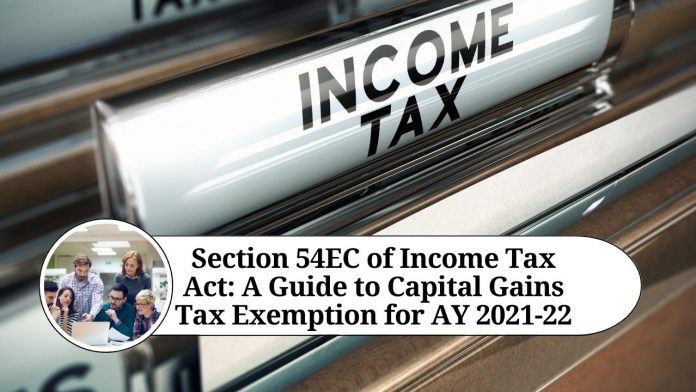If you have recently sold a capital asset and made a profit, you may be liable to pay capital gains tax. However, there are certain exemptions and deductions available under the Income Tax Act that can reduce your tax liability. One such exemption is provided under Section 54EC of the Income Tax Act, which allows you to save tax on long-term capital gains by investing in specified bonds. In this blog, we will discuss Section 54EC of the Income Tax Act in detail and how it can benefit you for AY 2021-22.
What is Section 54EC of Income Tax Act?
Section 54EC of the Income Tax Act provides an exemption from long-term capital gains tax arising from the transfer of a capital asset. Under this section, if you have made a profit by selling a capital asset such as property, shares, or mutual funds, you can invest the proceeds of the sale in specified bonds within a specified time frame to claim exemption from capital gains tax.
Which Bonds are specified for Section 54EC?
The government of India has notified certain bonds issued by the National Highways Authority of India (NHAI) and the Rural Electrification Corporation (REC) as eligible for investment under Section 54EC. These bonds have a lock-in period of three years and a maximum investment limit of Rs. 50 lakh in a financial year. The interest earned on these bonds is taxable, and TDS is applicable if the interest exceeds Rs. 5,000 in a financial year.
What are the Eligibility Criteria for Section 54EC?
To claim exemption under Section 54EC, the following eligibility criteria must be met:
- The exemption is available only for long-term capital gains arising from the transfer of a long-term capital asset.
- The investment must be made within six months from the date of transfer of the capital asset.
- The investment must be made in the specified bonds issued by NHAI or REC.
- The maximum investment allowed in a financial year is Rs. 50 lakh.
- The investment must be held for a minimum period of three years from the date of acquisition.
How to claim exemption under Section 54EC?
To claim exemption under Section 54EC, you need to follow these steps:
- Calculate the long-term capital gains arising from the transfer of a capital asset.
- Invest the amount of capital gains in the specified bonds issued by NHAI or REC within six months from the date of transfer of the capital asset.
- Submit Form 15G/15H to the issuer of the bond if you want to avoid TDS on interest earned.
- Hold the investment for a minimum period of three years.
- Claim exemption from capital gains tax in your income tax return for the relevant financial year.
Conclusion
Section 54EC of the Income Tax Act provides a significant tax-saving opportunity for taxpayers who have made long-term capital gains from the transfer of a capital asset. By investing in specified bonds issued by NHAI or REC, you can claim exemption from capital gains tax and reduce your tax liability. However, it is important to carefully follow the eligibility criteria and procedures to claim the exemption under this section. If you are unsure about the applicability of Section 54EC to your specific situation, it is advisable to consult a tax expert.
Read more useful content:
- section 145 of income tax act
- section 10e of income tax act
- section 9 of the income tax act
- section 94b of income tax act
- section 206aa of income tax act
Frequently Asked Questions (FAQs)
Q1. What is Section 54EC of the Income Tax Act?
A1. Section 54EC of the Income Tax Act provides an exemption from long-term capital gains tax arising from the transfer of a capital asset. This exemption can be claimed by investing in specified bonds within a specified time frame.
Q2. What is the time frame for investment under Section 54EC?
A2. The investment must be made within six months from the date of transfer of the capital asset to claim exemption under Section 54EC.
Q3. Which bonds are specified for investment under Section 54EC?
A3. The government of India has notified certain bonds issued by the National Highways Authority of India (NHAI) and the Rural Electrification Corporation (REC) as eligible for investment under Section 54EC.
Q4. What is the maximum investment limit under Section 54EC?
A4. The maximum investment allowed in a financial year is Rs. 50 lakh.
Q5. What is the lock-in period for investment under Section 54EC?
A5. The specified bonds have a lock-in period of three years from the date of acquisition.
Q6. Is the interest earned on specified bonds taxable?
A6. Yes, the interest earned on specified bonds is taxable, and TDS is applicable if the interest exceeds Rs. 5,000 in a financial year.
Q7. Can I claim exemption under Section 54EC for short-term capital gains?
A7. No, the exemption under Section 54EC is available only for long-term capital gains arising from the transfer of a long-term capital asset.
Q8. Can I claim exemption under Section 54EC for multiple capital gains?
A8. Yes, you can claim exemption under Section 54EC for multiple capital gains in a financial year, provided the maximum investment limit of Rs. 50 lakh is not exceeded.
Q9. Can I invest in specified bonds held in dematerialized form to claim exemption under Section 54EC?
A9. Yes, you can invest in specified bonds held in dematerialized form to claim exemption under Section 54EC.
Q10. Is it necessary to submit Form 15G/15H to the issuer of the bond to avoid TDS on interest earned?
A10. Yes, you need to submit Form 15G/15H to the issuer of the bond if you want to avoid TDS on interest earned.




















